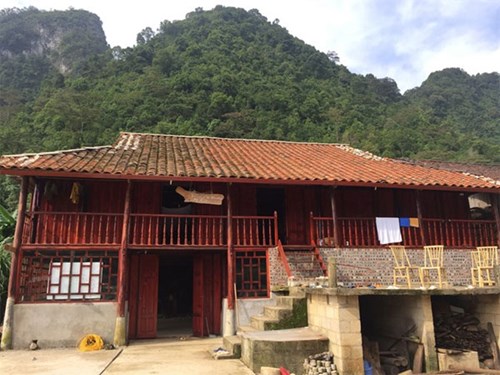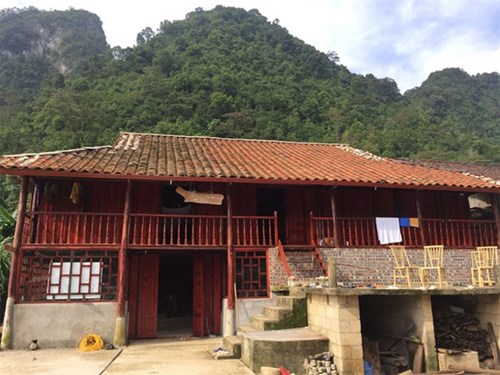


Nung people live in stilt
houses right next to their fields with domestic cattle being raised in the
shade under the house.

Homestay of Hoang Ngoc Kim in Phia Thap village, Cao Bang province. Photo: vietnamet.vn
Hoang Ngoc Kim’s home
stands out. Outside the newly-repaired house constructed from brightly-polished
wood hangs a small sign reading "Welcome to Homestay Mr. Kim.”
The traditional structure
of Kim’s stilt house is still preserved. The house’s first floor, which used to
be a cattle holding area, has been extended to make a cozy living room with
wooden tables and chairs.
The well-organized second
floor is where tourists can sleep, providing more than 20 mattresses and
eco-friendly decoration. Each mattress is well prepared with a pillow, a
mosquito net, a lamp and an electricity socket.
Kim is the only one in
the village with a homestay facility. Community-based tourism (CBT) projects
aided by the Center for Rural Economy Development (CRED) have been implemented
in the northern mountain provinces of Ha Giang and Cao Bang, where ethnic
minorities face many disadvantages. The model aims to create sustainable income
sources and employment opportunities for ethnic minority communities, improve
their sanitation and natural environment, and preserve traditional cultural
identities.
Everyone gets
involved
Kim was excited to talk
about his first trip to the tourist mecca of Sa Pa in Lao Cai province and Hoa
Binh province last year to learn about the homestay model.
"After the trip, I came
back home and started to repair my house last November. Two months ago, we
welcomed the first tourists. The most important thing is this is a
community-based tourism project so every member of our community can get
involved,” he said.
The CBT project not only
brings jobs to homestay owners like Kim, but also offers other services for
tourists. The more services, the more jobs it provides.
Just finishing a nearly
10km trek as a local tour guide, 20-year-old Thanh Mao was more than happy to
receive positive feedback from his tourists. This was his first time as a guide
after a training course for the Phia Thap villagers.
Several months ago, the
project chose six residents to participate in the training and Mao was lucky to
be one of them. The young boy used to stay home to help his parents with
farming. Now his daily job is to guide tourists on local trekking routes, with
which he is familiar.
"My limit is now English
so I will try to learn English to be able to help foreign tourists more,” he
said.
Besides homestay and tour
guide service, residents have set up a fleet of xe om (motorbike
taxi) and group of porters to help trekkers.
Community
empowerment
Phia Thap village is
located on the trekking route offered by the Cao Bang local authority.
Cao Dai Hung, the project
manager, says tourists on the trek can rest at traditional craft villages on
the way, such as the Pac Rang blacksmith village, Lung Ri tile-making village,
or relax at the homestay in Phia Thap village, which is well known for its
incense making tradition. They can observe how the locals make various items
and even learn how to make crafts.
"We want to maximize
social opportunities for local people. We target to provide them with direct
earning opportunities from homestays and tour guiding, and indirect income from
planting and breeding to supply food for tourists. When tourists come to visit
the villages, they also buy products. It is indirect profit,” he added.
The CBT also sets up
local funds managed by the community, which decides its capital rate, following
a management guidebook, contributing to community empowerment and
involvement.
"We provided VND 400
million (USD 17,400) to the fund. Kim’s family was the first one to borrow from
the fund. In five years, after his family pays off the loans, this money will
be rotated for lending to other families to build homestays. That is all about
the project’s sustainability," he said.
Moving the cattle
Besides income benefits,
environmental protection and cultural preservation are also a focus of the
projects.
"As a homestay owner, I
am always aware of protecting the environment. To protect the village’s
environment, we asked for sponsorship of the local authority to provide
wastebaskets for each house,” Kim said.
Hung said one of the
biggest difficulties encountered by such projects is to build local residents’
capacity to operate, manage and develop a tourism model in a sustainable way.
"It took us two to three months to change their awareness about moving domestic
cattle out of their houses. Raising cattle under the stilt houses and always
keeping animals is an ingrained habit of ethnic communities because buffalos,
pigs, cows are the most precious treasures of farmers. We have to persuade them
to understand why they have to change, and what benefits they will enjoy,” he
said.
So far ten households in
Phia Thap village moved their buffalo cages far from their living area. This
year, the authority targets to move another ten.
Potential
wonderland
Cao Bang province,
located nearly 300km to the northeast of the capital city, is home to
well-known destinations such as the Ban Gioc Waterfall, listed among the
world’s top 10 significant waterfalls, the Pac Bo Historical Site and the Non
Nuoc Cao Bang Geopark. Cao Bang has been chosen as one of five adventure
tourism spots in Southeast Asia.
Given the potential,
tourism has been identified as one of six key areas for socio-economic
development.
According to Truong The
Vinh, Deputy Director of the provincial Department of Culture, Sports and
Tourism, the province will review and list intangible cultural heritages of
ethnic groups this year, and has promoted the implementation of cultural
development and preservation program.
In the small wooden house
lit by warm oven fire, Kim, his wife, his son and daughter-in-law are still
hastily preparing dinner to welcome a new batch of tourists that evening. Each
of them wishes their lives and their neighbors’ livelihoods would be
better.
"Turning the age of 60,
my wife and me are no longer able to do hard work on the farm. I hope to
receive more tourists regularly and pass on my homestay experience to other
villagers,” Kim said.